Family: Xyelidae
Family common name: xyelid sawflies
Subfamily: Xyelinae
Tribe: Pleroneurini
Genus: Pleroneura Konow, 1897
Subgenera: none
Most phylogenies position Xyelidae as the most primitive family of all Hymenoptera. Most xyelids are associated with a primitive plant group, coniferousconiferous:
describing a conifer
trees (Ross 1932, Blank and Kramp 2017Blank and Kramp 2017:
Blank SM and Kramp K. 2017. Xyela davidsmithi (Hymenoptera, Xyelidae), a new pine catkin sawfly with an unusual host association from the Sierra Nevada. Proceedings of the Entomological Society of Washington 119 (Special Issue): 703-717.).
Pleroneura adults are small, about 5–8 mm in length, and are fairly uncommon. They can be a pest on fir trees in regions where firs grow (Carleton et al. 2014Carleton et al. 2014:
Carleton RD, Johns RC, Morrison A, and Morin B. 2014. Notes on the life-history of the balsam shootboring sawfly in the Maritimes region. Journal of the Acadian Entomological Society 10: 23-29.).
There are 12 described extantextant:
in existence; opposite of extinct
species worldwide, restricted to the Northern Hemisphere. Five species occur in North America (Taeger et al. 2010Taeger et al. 2010:
Taeger A, Blank SM, and Liston AD. 2010. World Catalog of Symphyta (Hymenoptera). Zootaxa 2580: 1-1064.).
A key to North American species of Pleroneura is included in Smith et al. 1977Smith et al. 1977:
Smith DR, Ohmart CP, and Dahlsten DL. 1977. The fir shoot-boring sawflies of the genus Pleroneura in North America (Hymenoptera: Xyelidae). Annals of the Entomological Society of America 70 (5): 762-767..
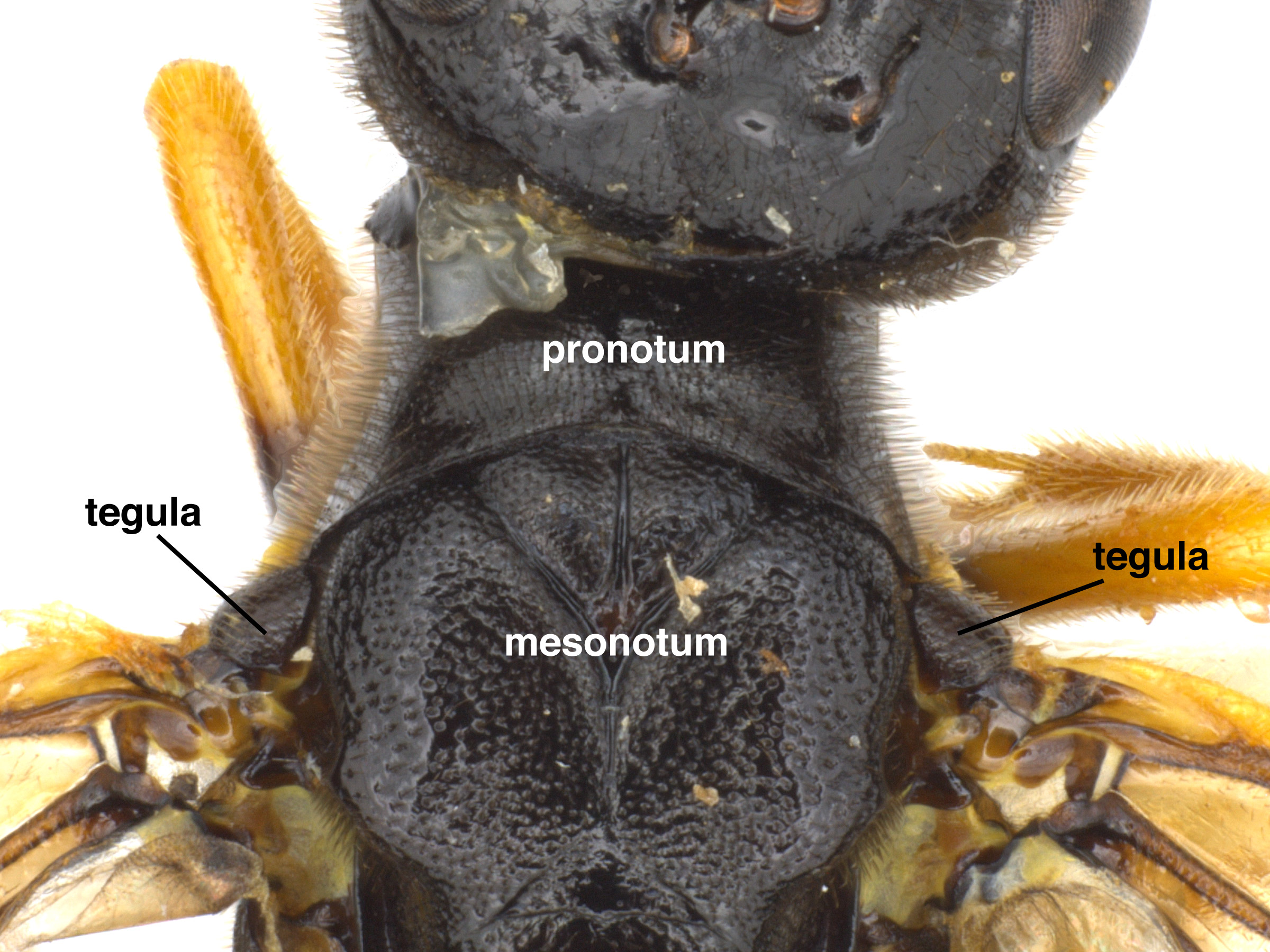 slightly constricted in the center, as seen from above (Goulet 1992Goulet 1992:
slightly constricted in the center, as seen from above (Goulet 1992Goulet 1992: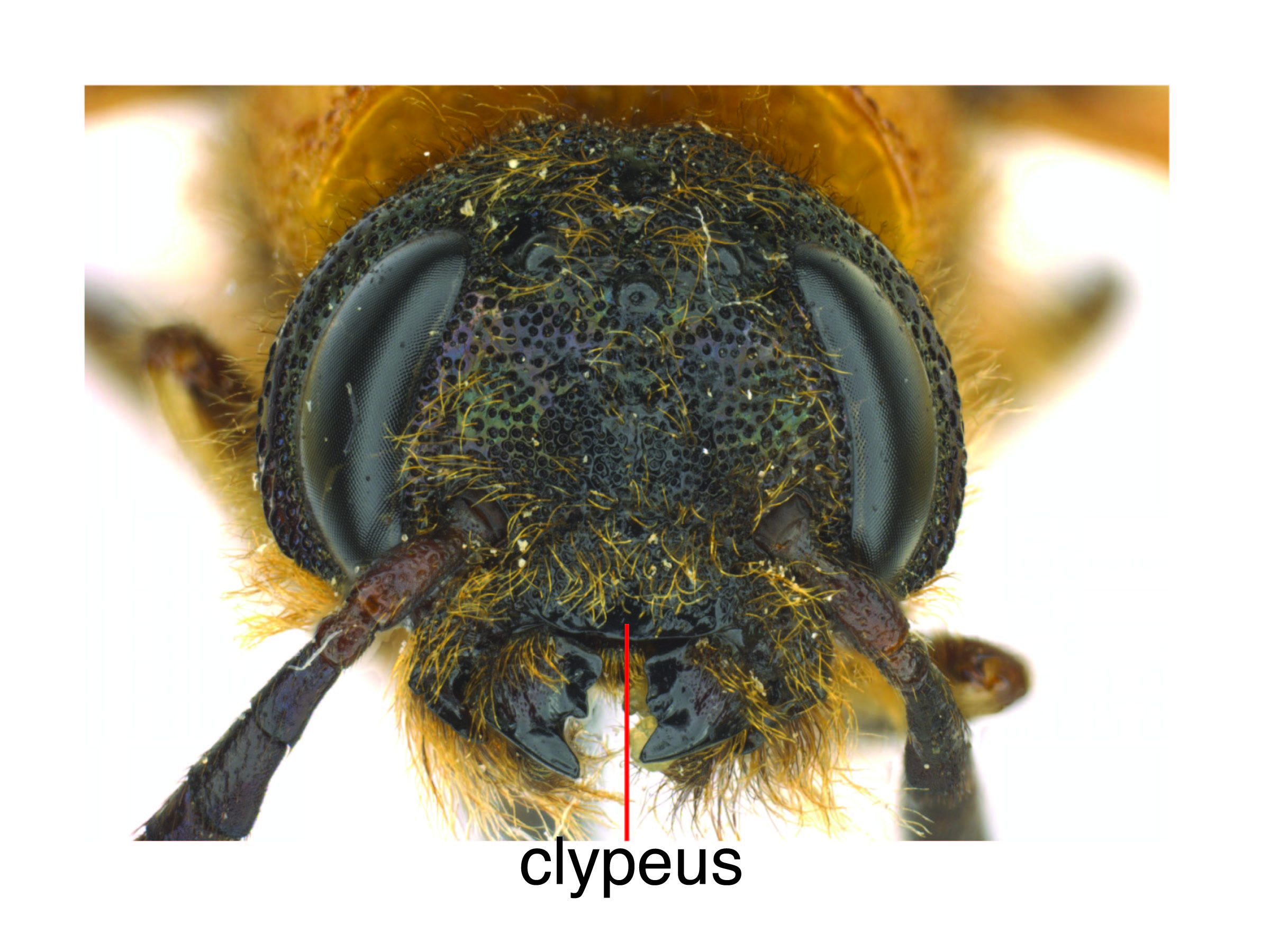 as measured at the basebase:
as measured at the basebase: ; narrower than 3 preceding segments (Burdick 1961Burdick 1961:
; narrower than 3 preceding segments (Burdick 1961Burdick 1961: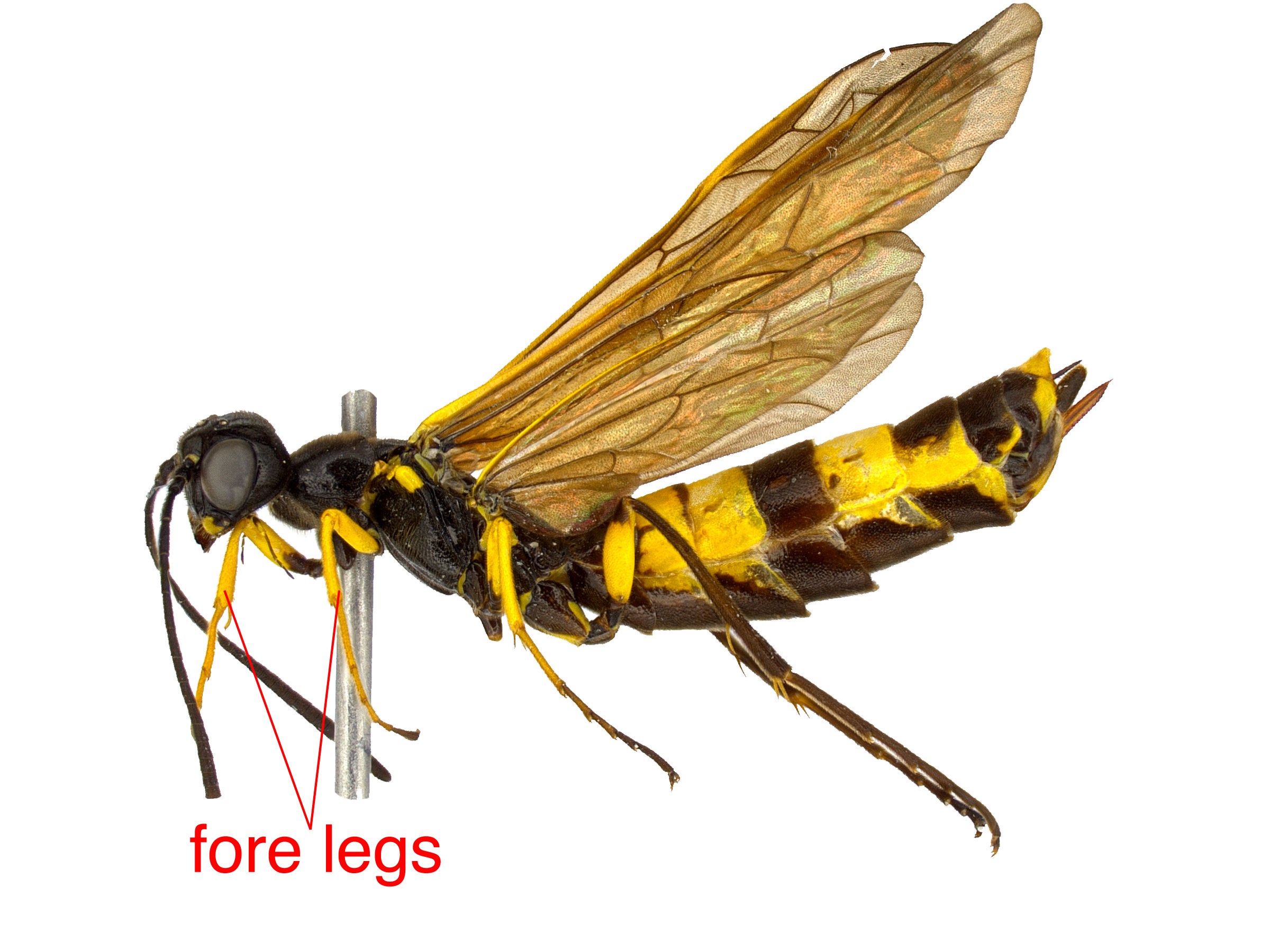 (Goulet 1992Goulet 1992:
(Goulet 1992Goulet 1992: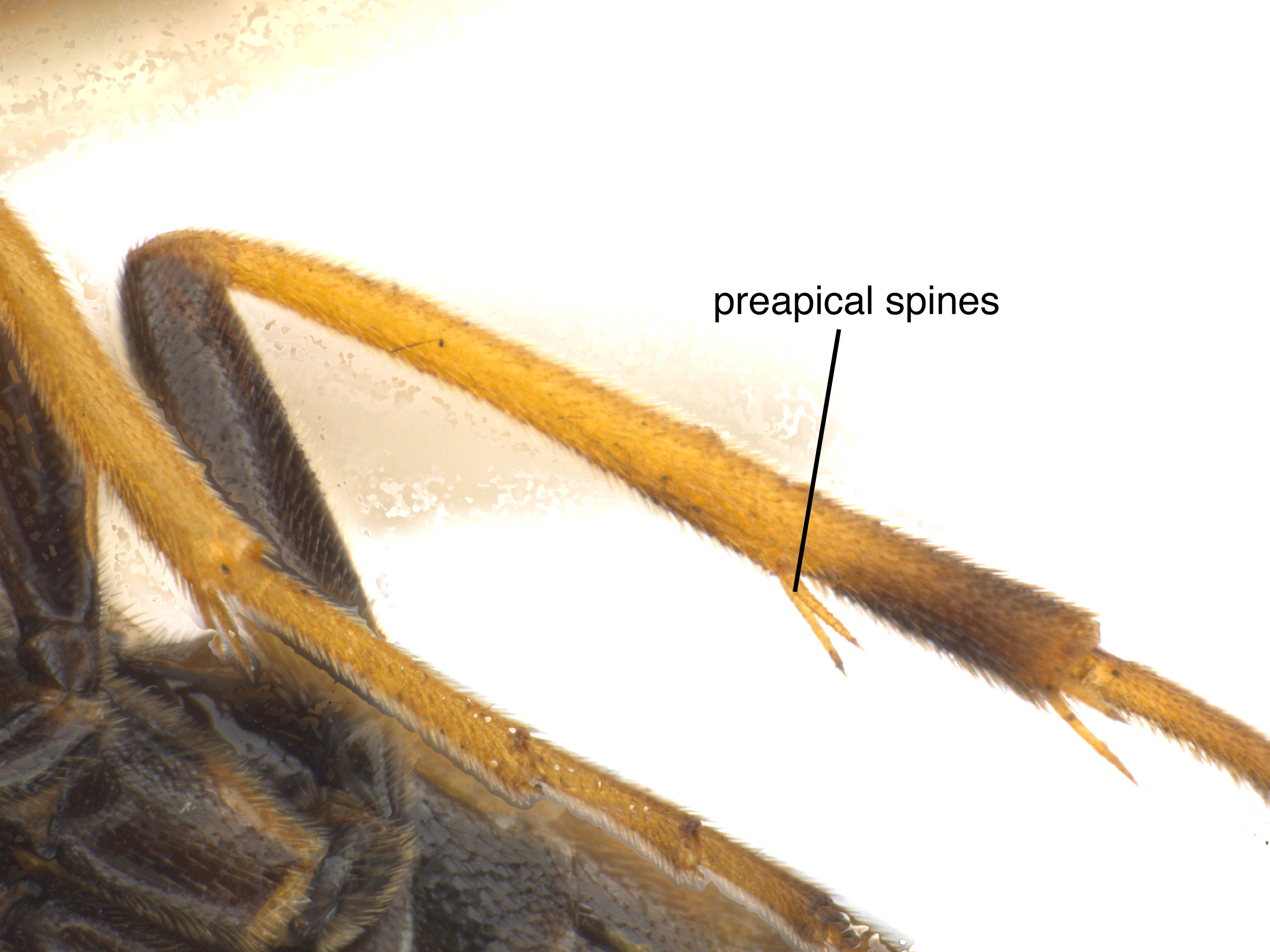 tibial spurs on the mid legmid leg:
tibial spurs on the mid legmid leg: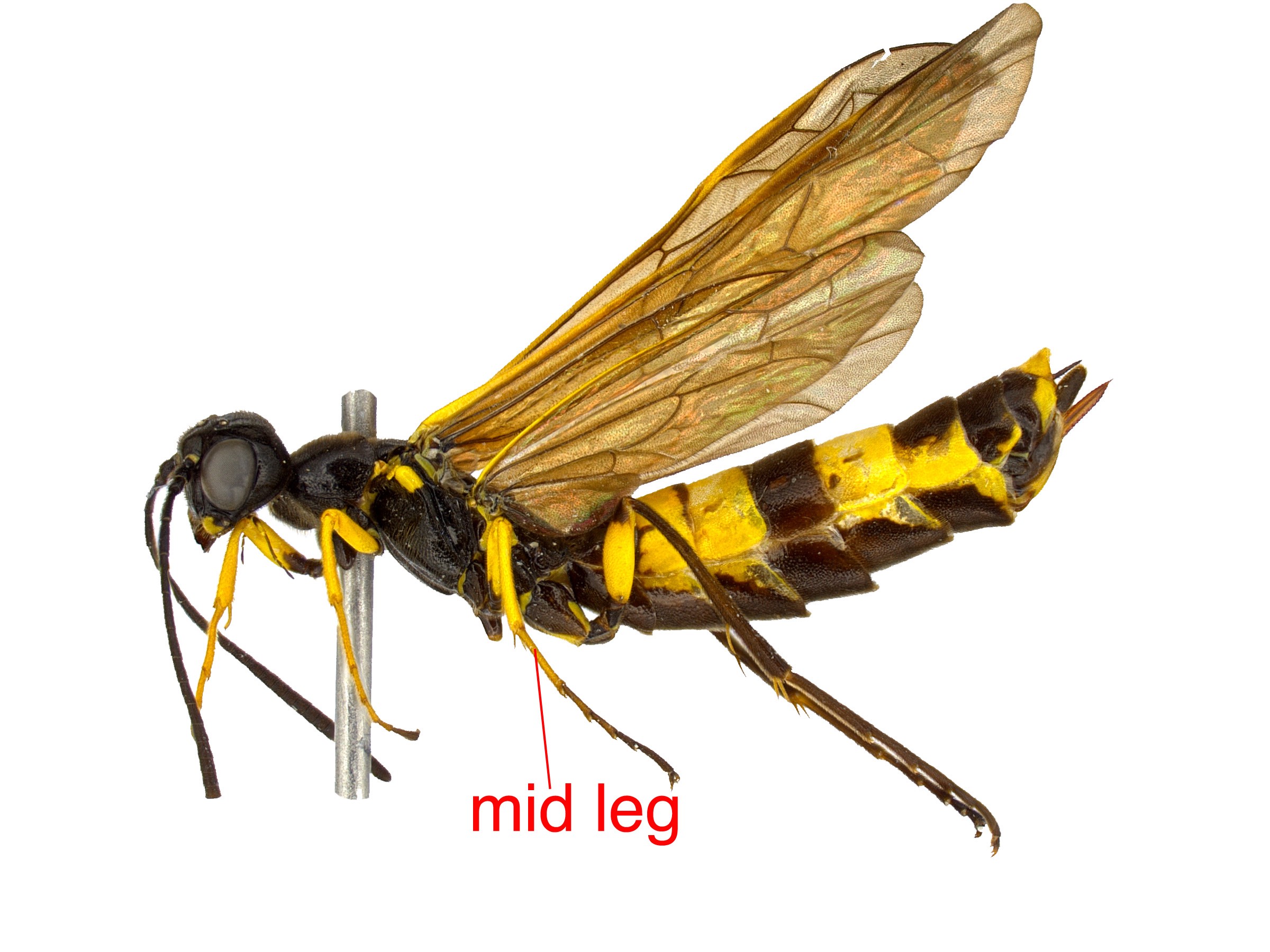 (Goulet 1992Goulet 1992:
(Goulet 1992Goulet 1992: with 12 segments: scapescape:
with 12 segments: scapescape: , pedicelpedicel:
, pedicelpedicel: , and 10 flagellomeres (Burdick 1961Burdick 1961:
, and 10 flagellomeres (Burdick 1961Burdick 1961: Sc of fore wingfore wing:
Sc of fore wingfore wing: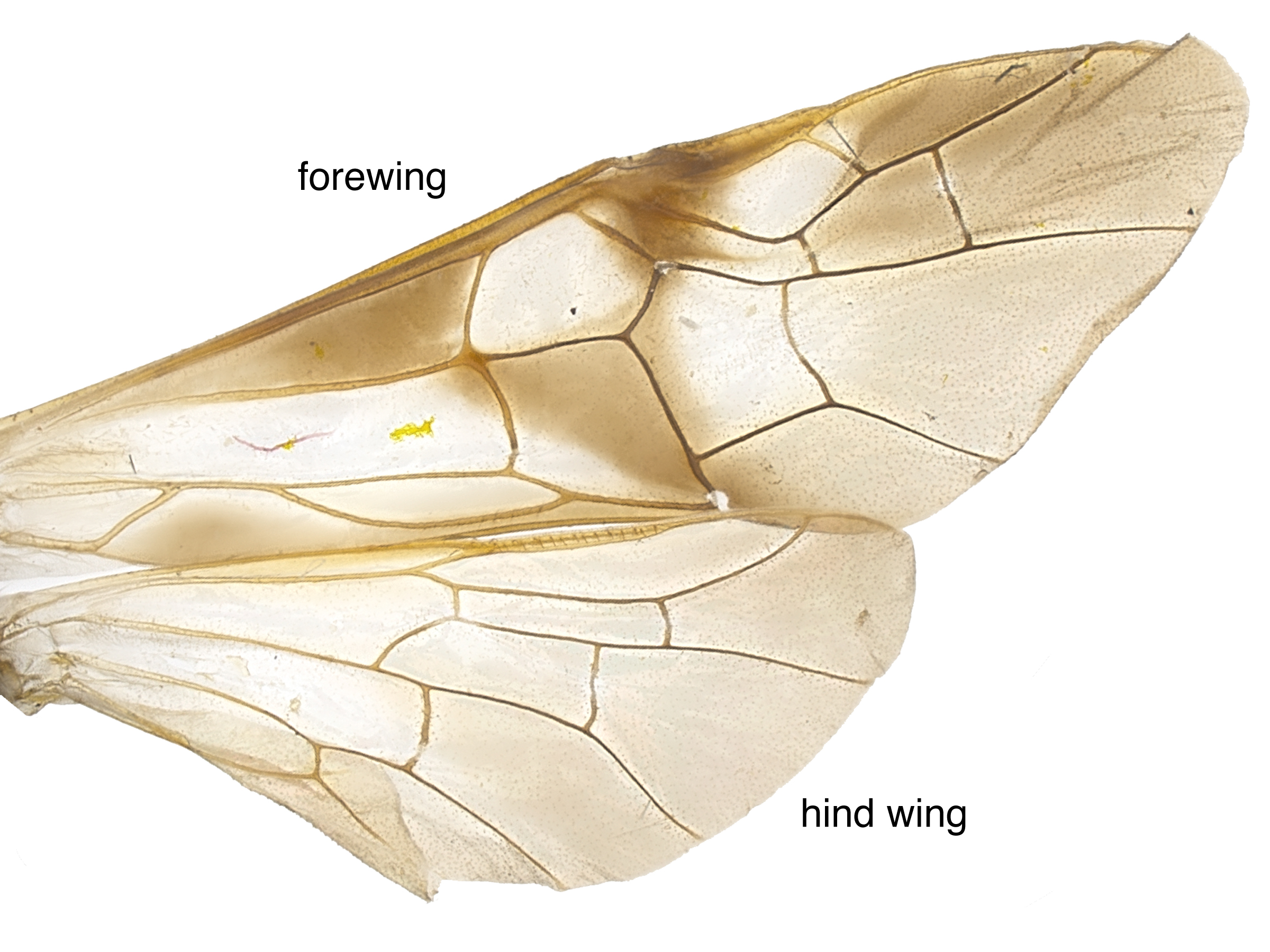 parallel to, but free from veinvein:
parallel to, but free from veinvein: R (Goulet 1992Goulet 1992:
R (Goulet 1992Goulet 1992: located basalbasal:
located basalbasal: of fore wingfore wing:
of fore wingfore wing: measuring three times as long as wide (Goulet 1992Goulet 1992:
measuring three times as long as wide (Goulet 1992Goulet 1992: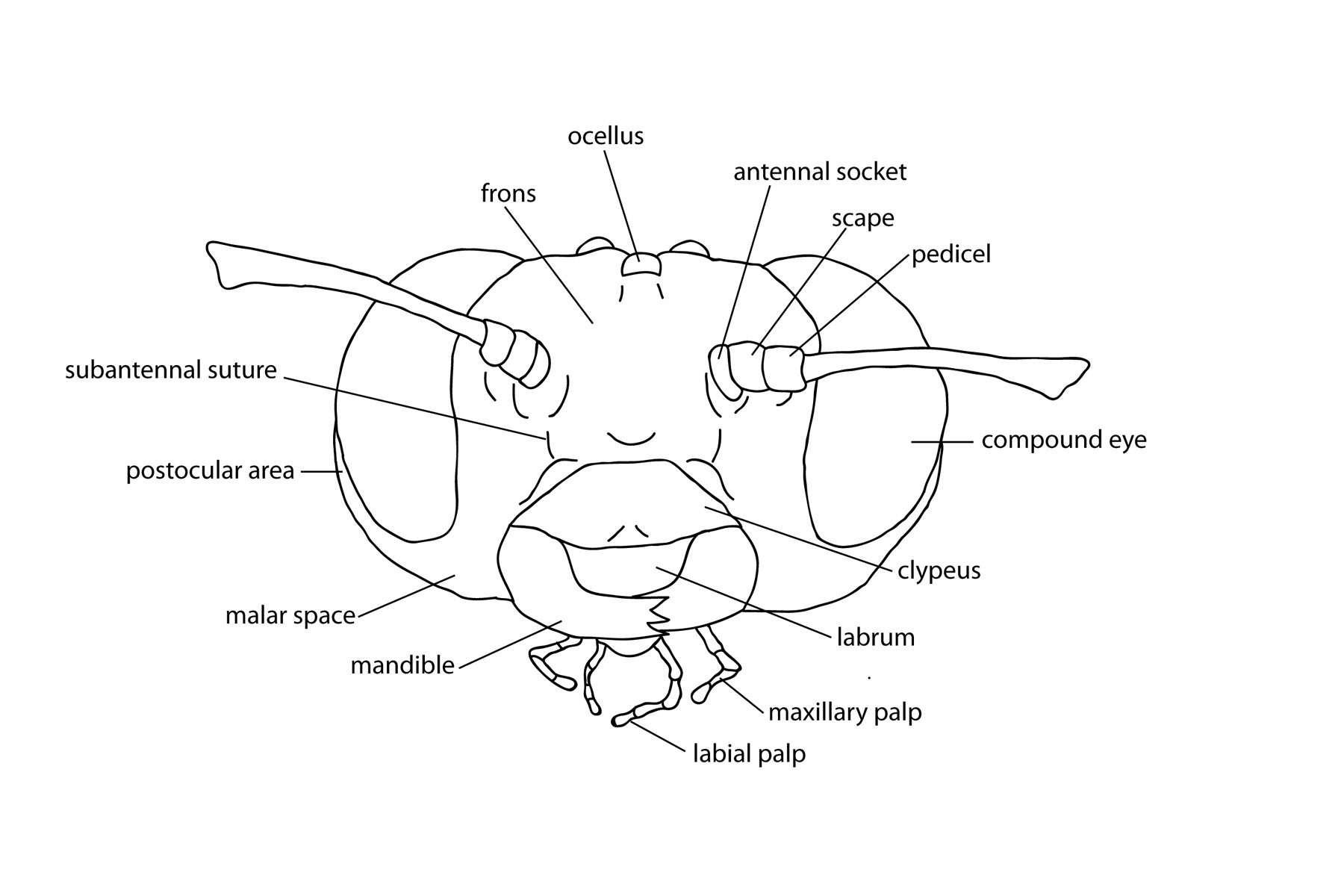 with a small irregular appendage at the apexapex:
with a small irregular appendage at the apexapex:Xyelidae can be distinguished from other families by the long ovipositorovipositor:
the female organ that deposits eggs and is used to drill into plant tissue, located at the apex of the abdomen, made up of the lance and lancet
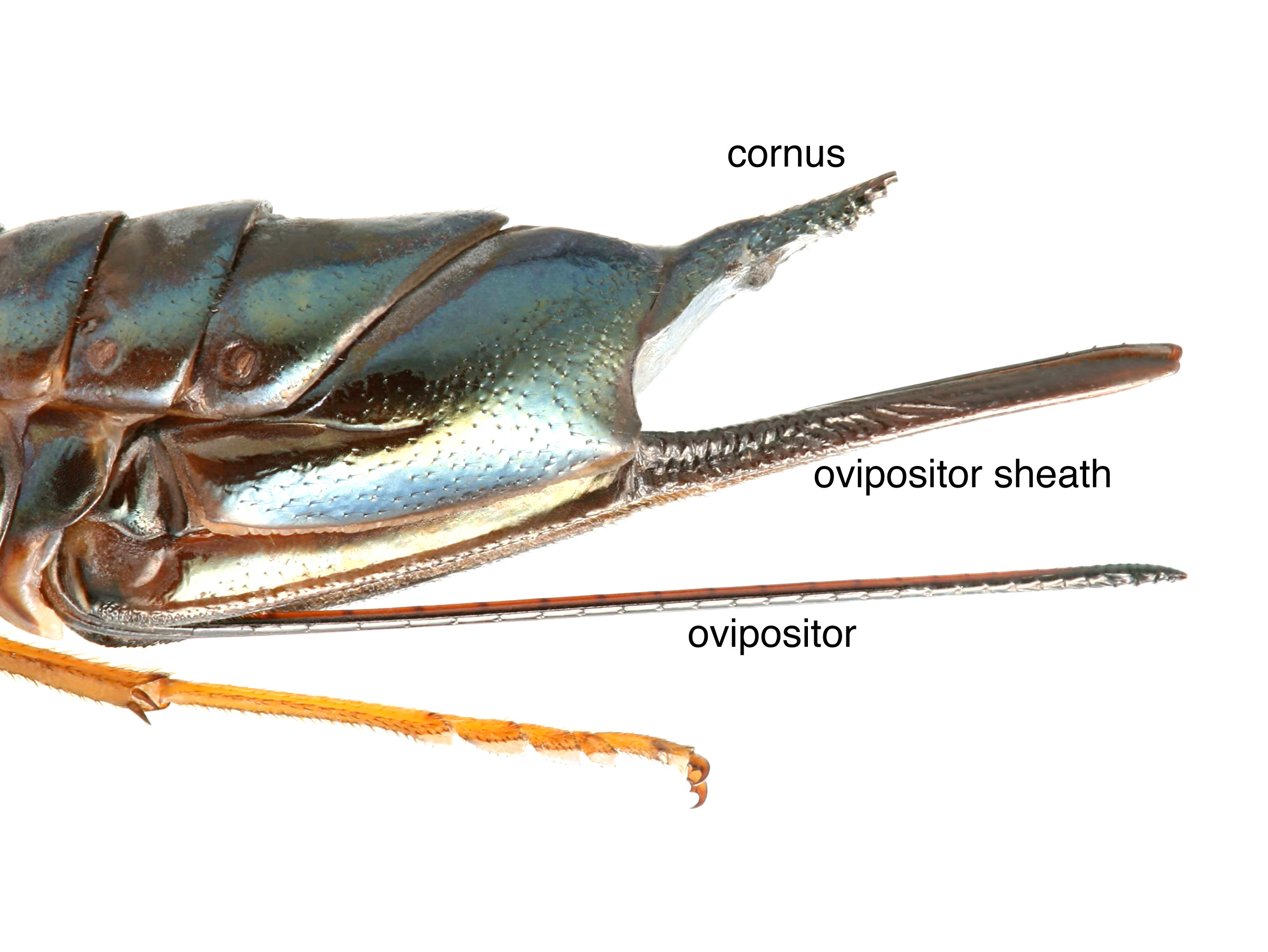 , and the characteristic elongate third antennal segment that is wider than the remaining flagellumflagellum:
, and the characteristic elongate third antennal segment that is wider than the remaining flagellumflagellum:
the third section of the antennae that includes all the segments beyond the pedicel; segments of the flagellum are known as flagellomeres
 . Pleroneura can easily be confused with other genera in the family. It can be distinguished by the number of antennal segments, the wing venationvenation:
. Pleroneura can easily be confused with other genera in the family. It can be distinguished by the number of antennal segments, the wing venationvenation:
the network of veins on a wing
, and maxillary palpusmaxillary palpus:
appendage emerging laterally from the maxilla; often segmented
 (Ross 1932, Goulet 1992Goulet 1992:
(Ross 1932, Goulet 1992Goulet 1992:
Goulet H. 1992. The genera and subgenera of the sawflies of Canada and Alaska: Hymenoptera. Symphyta. The insects and arachnids of Canada. Part 20. Agriculture Canada Publication.).
none
Larvae feed exclusively on Abies (fir) species (Smith et al. 1977Smith et al. 1977:
Smith DR, Ohmart CP, and Dahlsten DL. 1977. The fir shoot-boring sawflies of the genus Pleroneura in North America (Hymenoptera: Xyelidae). Annals of the Entomological Society of America 70 (5): 762-767.). In North America, the recorded host species are A. concolor (white fir), A. balsamea (balsam fir), and A. lasiocarpa (subalpine fir) (Smith et al. 1977Smith et al. 1977:
Smith DR, Ohmart CP, and Dahlsten DL. 1977. The fir shoot-boring sawflies of the genus Pleroneura in North America (Hymenoptera: Xyelidae). Annals of the Entomological Society of America 70 (5): 762-767., Smith 1978Smith 1978:
Smith DR. 1978. Suborder Symphyta (Xyelidae, Parachexyelidae, Parapamphiliidae, Xyelydidae, Karatavitidae, Gigasiricidae, Sepulcidae, Pseudosiricidae, Anaxyelidae, Siricidae, Xiphydriidae, Paroryssidae, Xyelotomidae, Blasticotomidae, Pergidae). Hymenopterorum Catalogus 14: 1-193.).
The female uses the elongate ovipositorovipositor:
the female organ that deposits eggs and is used to drill into plant tissue, located at the apex of the abdomen, made up of the lance and lancet
 to deposit eggs into unopened leaf buds. The leaf bud scales provide protection for the egg until it hatches (Ohmart and Dahlsten 1979Ohmart and Dahlsten 1979:
to deposit eggs into unopened leaf buds. The leaf bud scales provide protection for the egg until it hatches (Ohmart and Dahlsten 1979Ohmart and Dahlsten 1979:
Ohmart CP and Dahlsten DL. 1979. Biological studies of bud mining sawflies, Pleroneura spp. (Hymenoptera: Xyelidae), on white fir in the central Sierra Nevada of California III. Mortality factors of egg, larval, and adult stages and a partial life table. Canadian Entomologist 111: 883-888., Carleton et al. 2014Carleton et al. 2014:
Carleton RD, Johns RC, Morrison A, and Morin B. 2014. Notes on the life-history of the balsam shootboring sawfly in the Maritimes region. Journal of the Acadian Entomological Society 10: 23-29.). After hatching, the larvalarva:
the immature stage of holometabolous insects
 feeds on the growth tip of a new young shoot, often leading to mortality of the shoot (Smith et al. 1977Smith et al. 1977:
feeds on the growth tip of a new young shoot, often leading to mortality of the shoot (Smith et al. 1977Smith et al. 1977:
Smith DR, Ohmart CP, and Dahlsten DL. 1977. The fir shoot-boring sawflies of the genus Pleroneura in North America (Hymenoptera: Xyelidae). Annals of the Entomological Society of America 70 (5): 762-767.). LarvaeLarva:
the immature stage of holometabolous insects
 are cylindrical, white, and stout; at maturity they measure 6–9 mm in length (Smith 1967bSmith 1967b:
are cylindrical, white, and stout; at maturity they measure 6–9 mm in length (Smith 1967bSmith 1967b:
Smith DR. 1967b. A review of the larvae of Xyelidae, with notes on the family classification (Hymenoptera). Annals of the Entomological Society of America 60 (2): 376-384.) and drop to the ground to overwinter and pupate (Ohmart and Dahlsten 1979Ohmart and Dahlsten 1979:
Ohmart CP and Dahlsten DL. 1979. Biological studies of bud mining sawflies, Pleroneura spp. (Hymenoptera: Xyelidae), on white fir in the central Sierra Nevada of California III. Mortality factors of egg, larval, and adult stages and a partial life table. Canadian Entomologist 111: 883-888., Carleton et al. 2014Carleton et al. 2014:
Carleton RD, Johns RC, Morrison A, and Morin B. 2014. Notes on the life-history of the balsam shootboring sawfly in the Maritimes region. Journal of the Acadian Entomological Society 10: 23-29.).
World: Pleroneura occurs in North America, eastern and central Europe, and East Asia (Taeger et al. 2010Taeger et al. 2010:
Taeger A, Blank SM, and Liston AD. 2010. World Catalog of Symphyta (Hymenoptera). Zootaxa 2580: 1-1064.).
North America: Four of the five species of North American Pleroneura occur west of the Rocky Mountains, from California north to British Columbia, as far east as Utah. The range of P. brunneicornis extends through New England, New York, and the eastern provinces of Canada; Nova Scotia, New Brunswick, and Quebec (Smith et al. 1977Smith et al. 1977:
Smith DR, Ohmart CP, and Dahlsten DL. 1977. The fir shoot-boring sawflies of the genus Pleroneura in North America (Hymenoptera: Xyelidae). Annals of the Entomological Society of America 70 (5): 762-767., Smith 1978Smith 1978:
Smith DR. 1978. Suborder Symphyta (Xyelidae, Parachexyelidae, Parapamphiliidae, Xyelydidae, Karatavitidae, Gigasiricidae, Sepulcidae, Pseudosiricidae, Anaxyelidae, Siricidae, Xiphydriidae, Paroryssidae, Xyelotomidae, Blasticotomidae, Pergidae). Hymenopterorum Catalogus 14: 1-193., Taeger et al. 2010Taeger et al. 2010:
Taeger A, Blank SM, and Liston AD. 2010. World Catalog of Symphyta (Hymenoptera). Zootaxa 2580: 1-1064.).
Map data from: GBIF.org (26 June 2019) GBIF Occurrence Download Pleroneura
Details about data used for maps can be found here.